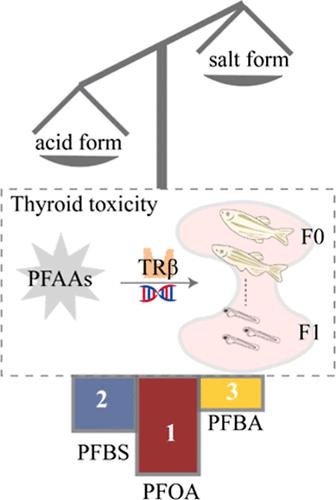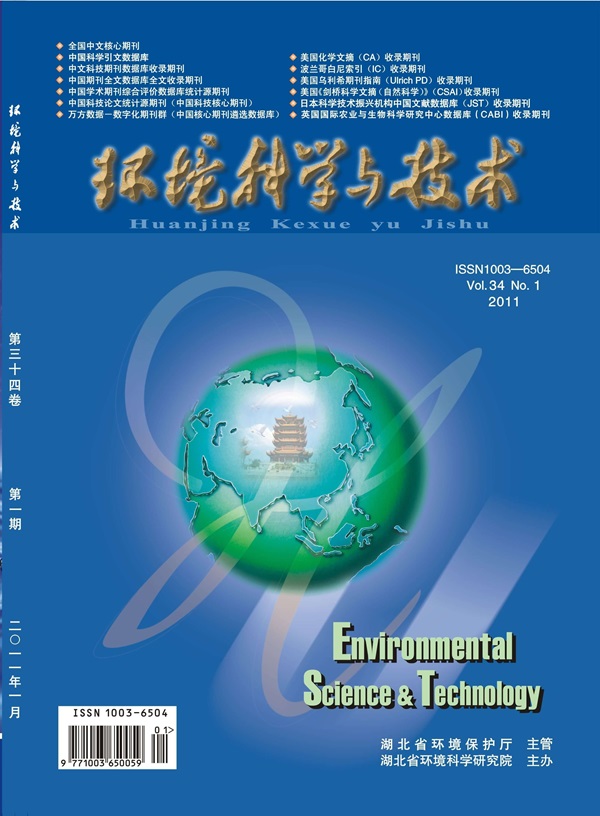Effects of Chemical Speciation on Chronic Thyroid Toxicity of Representative Perfluoroalkyl Acids
IF 11.3
1区 环境科学与生态学
Q1 ENGINEERING, ENVIRONMENTAL
引用次数: 0
Abstract
Acute exposure studies have reported that chemical speciation significantly affects the developmental toxicity of perfluoroalkyl acids (PFAAs). However, the mechanisms underlying the chronic toxicity of PFAAs as a function of chemical speciation remain unknown. With an aim to gain more insights into the PFAA structure–toxicity relationship, this study exposed adult zebrafish to the acids and salts of perfluorooctanoate (PFOA), perfluorobutanoate (PFBA), and perfluorobutanesulfonate (PFBS) at environmentally realistic concentrations for 5 months. In the F0 generation, PFAA acids induced hypothyroidism symptoms more potently than their salt counterparts. After parental exposure, a chemical speciation-dependent transfer behavior was noted, with a greater burden of PFAA acids in the offspring. Similarly, PFAA acids were associated with higher risks of transgenerational defects and thyroid dysfunction during offspring embryogenesis. PFAA acids bound to thyroid receptor beta (TRβ) more strongly than their salts. An antagonistic interaction of PFOA and PFBS with TR activity was observed in vitro via the reduction of TRβ accessibility to target genes. CUT&Tag sequencing revealed disturbances due to PFAAs on the genomic target profile of TRβ, indicating that PFOA and PFBS interfere with multiple thyroidal and nervous processes. In conclusion, current findings provided evidence regarding the critical effects of chemical speciation on PFAA toxicity, highlighting the need to perform discriminative risk assessment and chemical management.

化学形态对代表性全氟烷基酸慢性甲状腺毒性的影响
急性接触研究报告指出,化学物种形成显著影响全氟烷基酸的发育毒性。然而,PFAAs的慢性毒性机制作为化学物种形成的功能仍然未知。为了更深入地了解PFAA的结构-毒性关系,本研究将成年斑马鱼以符合环境要求的浓度暴露于全氟辛酸(PFOA)、全氟丁酸(PFBA)和全氟丁烷磺酸(PFBS)的酸和盐中5个月。在F0代中,PFAA酸比盐更有效地诱导甲状腺功能减退症状。在父母接触后,发现了一种化学物种依赖的转移行为,后代中PFAA酸的负担更大。同样,PFAA酸与后代胚胎发育过程中跨代缺陷和甲状腺功能障碍的高风险相关。PFAA酸与甲状腺受体(TRβ)的结合比其盐类更强。PFOA和PFBS通过降低TRβ对靶基因的可及性,在体外观察到与TR活性的拮抗相互作用。CUT&;Tag测序显示PFAAs对TRβ基因组靶谱的干扰,表明PFOA和PFBS干扰多个甲状腺和神经过程。总之,目前的研究结果提供了关于化学形态对PFAA毒性的关键影响的证据,强调了进行歧视性风险评估和化学品管理的必要性。
本文章由计算机程序翻译,如有差异,请以英文原文为准。
求助全文
约1分钟内获得全文
求助全文
来源期刊

环境科学与技术
环境科学-工程:环境
CiteScore
17.50
自引率
9.60%
发文量
12359
审稿时长
2.8 months
期刊介绍:
Environmental Science & Technology (ES&T) is a co-sponsored academic and technical magazine by the Hubei Provincial Environmental Protection Bureau and the Hubei Provincial Academy of Environmental Sciences.
Environmental Science & Technology (ES&T) holds the status of Chinese core journals, scientific papers source journals of China, Chinese Science Citation Database source journals, and Chinese Academic Journal Comprehensive Evaluation Database source journals. This publication focuses on the academic field of environmental protection, featuring articles related to environmental protection and technical advancements.
 求助内容:
求助内容: 应助结果提醒方式:
应助结果提醒方式:


